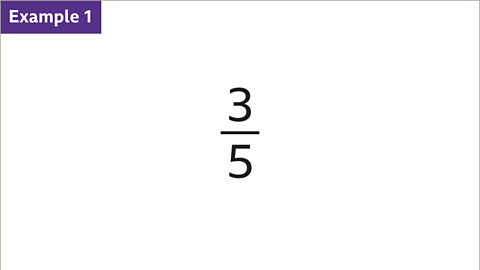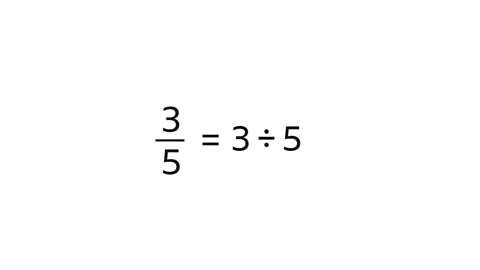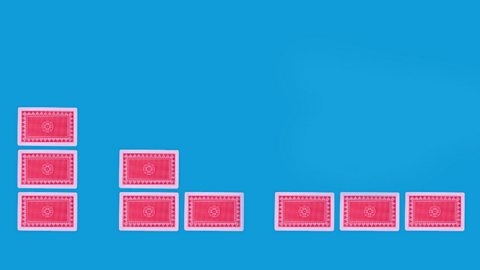Fractions
- A fraction is part of a whole and is shown by writing one whole number above another.
- The top number is called the numerator and the bottom number is the denominator.
Equivalent fractions
Fractions are equivalent if they are equal in value.
The diagram shows that \( \LARGE \frac{1}{2}= \frac{2}{4}\)
Equivalent fractions can be created by:
- multiplying both the numerator and the denominator by the same number
\(\LARGE{\frac{1}{2}} \Large{\genfrac{}{}{-0.0001pt}{}{\times 12}{\times 12} = } \LARGE{\frac{12}{24}}\)
or
- dividing both the numerator and denominator by a number which divides exactly into both.
\(\LARGE{\frac{6}{9}} \Large{\genfrac{}{}{-0.0001pt}{}{\div 3}{\div3} = } \LARGE{\frac{2}{3}}\)
To decide if two fractions are equivalent:
Simplify each fraction to its lowest terms and then compare the two fractions. If the simplest form of each is the same, then the two fractions are equivalent.
\(\LARGE{\frac{14}{20}} \Large{\genfrac{}{}{-0.0001pt}{}{\div 2}{\div2} } = \LARGE{\frac{7}{10}} \quad \LARGE{\frac{35}{50}} \Large{\genfrac{}{}{-0.0001pt}{}{\div 5}{\div 5}} = {\frac{7}{10}}\)
These two fractions are equivalent because they both cancel down to \({\frac{7}{10}}\)
Example
Some of these fractions are equivalent to \(\large {\frac{4}{5}}\). Which ones?
| A | B | C | D |
|---|---|---|---|
| \(\large {\frac{8}{20}}\) | \(\large {\frac{20}{30}}\) | \(\large {\frac{16}{20}}\) | \(\large {\frac{8}{10}}\) |
Solution
Cancel each fraction into its lowest terms
| A \(\large {\frac{8}{20}}= {\frac{2}{5}}\) | B \(\large {\frac{20}{30}}= {\frac{2}{3}}\) | C\(\large \color{green} {\frac{16}{20}}= {\frac{4}{5}}\) | D \(\large \color{green} {\frac{8}{10}}= {\frac{4}{5}}\) |
Answer Both \(\large {\frac{16}{20}}\)and \(\large {\frac{8}{10}}\) are equivalent to \(\large {\frac{4}{5}}\)
What is the missing number?
\(\LARGE {\frac{4}{9}}= {\frac{\color{red}\Box}{45}}\)
Solution
\(\LARGE\frac{4}{9} \Large\color{red}{\genfrac{}{}{-0.0001pt}{}{\times 5}{\times 5}} = \LARGE\color{black}{\frac{\color{red}\Box}{45}} \quad \quad \LARGE\color{black}\frac{4}{9} \Large\color{red}{\genfrac{}{}{-0.0001pt}{}{\times 5}{\times 5}} = \LARGE\color{black}\frac{\color{red}20}{45}\)
Answer 20
Which of the fractions is not equivalent to \({\frac{4}{5}}\)
| A | B | C | D |
|---|---|---|---|
| \(\large {\frac{24}{30}}\) | \(\large {\frac{2}{3}}\) | \(\large {\frac{12}{15}}\) | \(\large {\frac{8}{10}}\) |
Solution
Cancel each fraction into its lowest terms
| A \(\Large {\frac{24}{30}} \large\color{red}{\genfrac{}{}{-0.0001pt}{}{\div 6}{\div 6}} = {\frac{4}{5}}\) | C \(\Large {\frac{12}{15}} \large\color{red}{\genfrac{}{}{-0.0001pt}{}{\div 3}{\div 3}}= \color{black}{\frac{4}{5}}\) | D\(\Large {\frac{8}{10}} \large\color{red}{\genfrac{}{}{-0.0001pt}{}{\div 2}{\div 2}} = \color{black}{\frac{4}{5}}\) |
are all equal to \({\frac{4}{5}}\)
Answer
B \(\Large {\frac{2}{3}}\)
is already in its simplest form and not equal to \({\frac{4}{5}}\)
What is the missing number?
\(\LARGE {\frac{7}{9}}= {\frac{\color{red}\Box}{36}}\)
Solution
\(\LARGE\frac{7}{9} \Large\color{red}{\genfrac{}{}{-0.0001pt}{}{\times 4}{\times 4}} = \LARGE\color{black}\frac{\color{red}28}{36}\)
Answer: The missing number is 28
How to convert a fraction to a decimal
Using equivalent fractions
- Write an equivalent fraction with a denominator 10, 100 or 1000
- Use place value to convert the fraction to a decimal

Image caption, A fraction is one way of writing a division. The numerator is divided by the denominator. Fractions can be converted into decimals by processing this division. Convert 3â5 to a decimal.
Image caption, 5 is a factor of 10. 5 x 2 = 10. Find the equivalent fraction for 3â5
Image caption, Find the equivalent fraction for 3â5 by multiplying the numerator and denominator by 2
Image caption, 3â5 is equivalent to 6â10
Image caption, 3â5 is equivalent to 6â10. 6â10 is 0â6. 3â5 is 0â6 as a decimal.
1 of 5
Using division
- Fractions can be converted into decimals by dividing the numerator by the denominator using the short division method or on the calculator.

Image caption, A fraction is one way of writing a division. The numerator is divided by the denominator. Fractions can be converted into decimals by processing this division. Convert 3â5 to a decimal.
Image caption, Using short division - 3.0 divided by 5 = 0.6
Image caption, 3â5 is equivalent to 0â6 as a decimal.
1 of 3
Test yourself
More on M1: Number
Find out more by working through a topic
- count3 of 7

- count4 of 7

- count6 of 7
